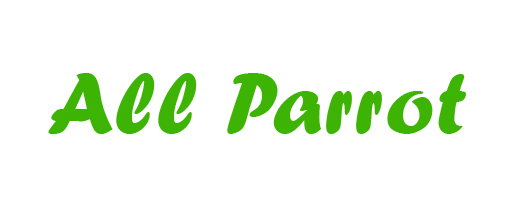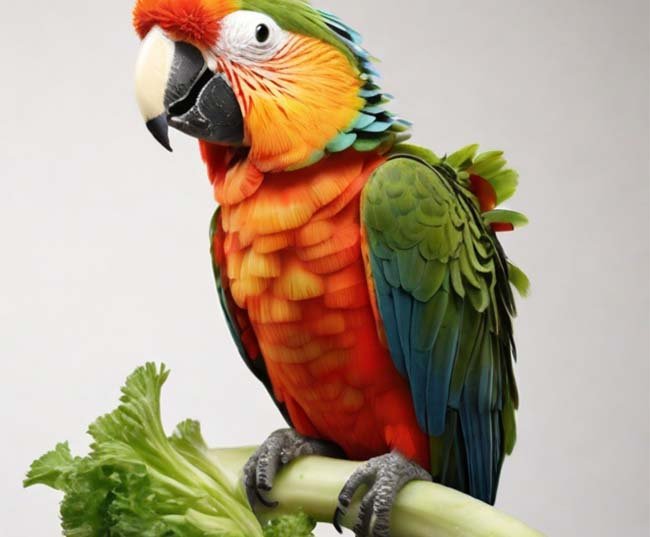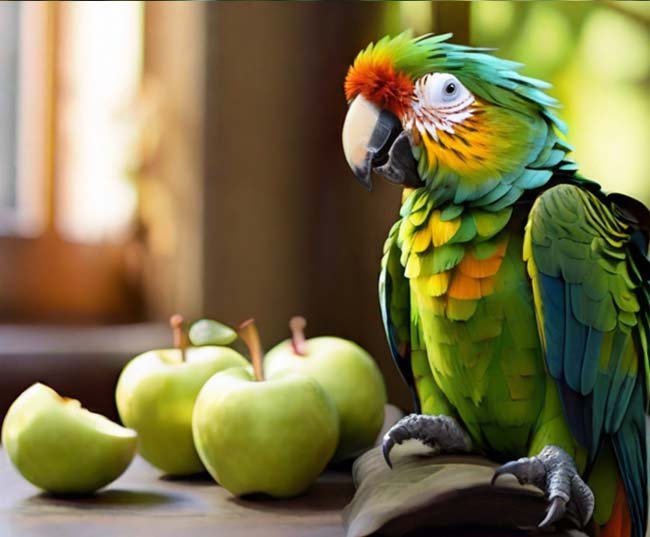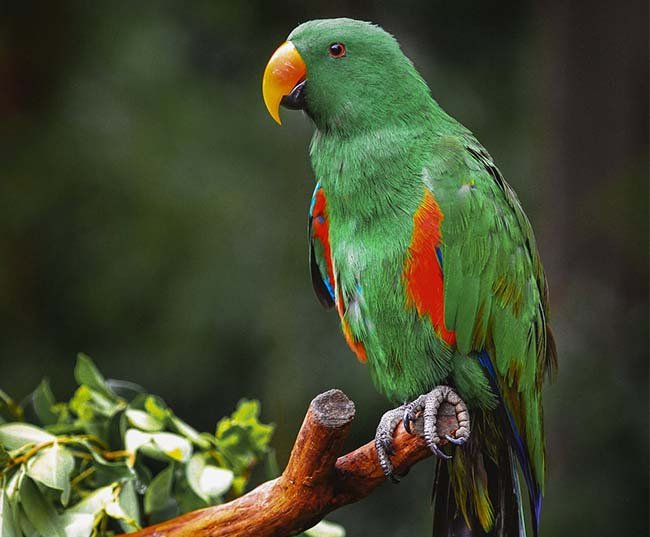Can Parrots Eat Tomatoes Safely? Parrot Diet tips

If you’re a parrot owner wondering whether it’s safe to give your feathered friend some tomatoes, you’re not alone.
Tomatoes are a common household food item, and you may be tempted to share them with your pet.
However, it’s important to know whether tomatoes are safe for parrots and how to incorporate them into their diet.
So without any delay, let’s get straight into it for a better understanding.
Key Takeaways:
- Not all tomatoes are safe for parrots, and it’s important to choose the right variety.
- Tomatoes can provide health benefits for parrots but should be served in moderation.
- Raw tomatoes may be more difficult for parrots to digest than cooked ones.
- You should monitor your parrot’s reaction to tomatoes and adjust their diet if necessary.
- As with any new food, it’s best to offer tomatoes gradually and in small amounts to avoid digestive upset.
Can Parrots Eat Tomatoes? Explained
Parrots can eat tomatoes, but only in small amounts as an occasional treat. Tomatoes contain solanine, which is a substance that can be toxic to parrots if they eat too much.
Solanine is found in all parts of the tomato plant, including the fruit, stems, and leaves.
A few bites of ripe tomato flesh are usually okay for most parrots. But avoid feeding them too many seeds or skin, since those parts have higher solanine levels.
And never give them tomato plant parts like the leaves and stems, as those contain very high levels of solanine that can make your parrot sick.
Some good rules when giving your parrot tomatoes are:
- Only feed ripe tomatoes, not unripe green ones
- Only give them a few small bites, not a whole tomato
- Remove the seeds and skin before feeding
- Never give tomato plant parts like vines and stems
Following those tips will allow your parrot to enjoy tomatoes as an occasional snack while staying safe and healthy.
The small amount of tomato flesh is a nice way to provide some variety in their diets.
But tomatoes should never be a main food item. And if you notice any signs of illness after feeding tomatoes, stop giving them immediately.
By being careful with amounts, you can allow your parrot to this yummy snack!
1). The Benefits of Tomatoes for Parrots
Tomatoes are a nutritious food that can offer several health benefits for parrots. They are rich in essential vitamins and minerals, including:
- Vitamin A
- vitamin C
- and potassium
Which can support a parrot’s immune system and overall health.
Tomatoes contain antioxidants that can help prevent cellular damage and reduce the risk of certain diseases.
These antioxidants also support healthy vision and skin, keeping your parrot looking and feeling great.
Nutritional Value of Tomatoes for Parrots
A single medium-sized tomato contains approximately (22 calories, 1.1 grams of protein, and 2.2 grams of fiber).
Tomatoes are also low in fat, with less than 0.5 grams per serving.
| Nutrition Facts of Tomatoes for Parrots | Per 1 Medium-Sized Tomato (91g) |
|---|---|
| Calories | 22 |
| Protein | 1.1g |
| Fiber | 2.2g |
| Fat | less than 0.5g |
| Vitamin A | 1025 IU |
| Vitamin C | 15.6mg |
| Potassium | 292mg |
Overall, tomatoes are a nutritious addition to a parrot’s diet and can offer several health benefits.
However, it’s important to feed them in moderation and monitor your parrot’s reaction to ensure their safety.
2). Risks of Feeding Tomatoes to Parrots
While tomatoes can offer nutritional value to parrots, there are also risks associated with feeding them to our feathered friends.
One of the most significant concerns is the potential toxicity of certain tomato components.
Tomatoes and their leaves contain small amounts of solanine, a harmful compound found in nightshade plants.
While the concentration of solanine in ripe tomatoes is generally low, the level can increase as they spoil or become overripe.
Additionally, the leaves and stems of the tomato plant contain higher levels of solanine than the fruit itself, making them particularly dangerous for parrots.
Another risk associated with feeding tomatoes to parrots is the potential for allergic reactions.
Like humans, parrots can develop allergies to certain foods, and tomatoes are no exception. Symptoms of an allergic reaction can include breathing difficulties, feather plucking, and skin irritation.
To mitigate these risks and ensure tomato safety for parrots, it is crucial to follow proper feeding guidelines.
This includes feeding only small amounts of ripe tomato fruit to parrots and avoiding any spoiled or overripe tomatoes.
It is essential to remove all leaves, stems, and seeds as they are potentially toxic. When introducing tomatoes to a parrot’s diet, it is best to start with small amounts and monitor their reaction closely.
Ensuring tomato safety for parrots can help prevent potential health issues and keep our feathered friends healthy and happy.
3). Parrot-Friendly Tomato Varieties
Tomatoes can be a healthy addition to a parrot’s diet, but it’s important to choose safe varieties that are free of harmful substances.
Here are some parrot-friendly tomatoes to consider:
| Tomato Variety | Description |
|---|---|
| Cherry Tomatoes | Small and sweet, these tomatoes make a great snack for parrots. |
| Heirloom Tomatoes | These flavorful tomatoes come in a variety of colors and are packed with vitamins and minerals. |
| Roma Tomatoes | These firm and meaty tomatoes are perfect for cooking and are low in acidity. |
| Beefsteak Tomatoes | These large and juicy tomatoes are a good source of vitamin C. |
It’s important to only feed your parrot ripe tomatoes, as unripe tomatoes contain solanine, a toxic substance that can harm your parrot’s health.
Other than that, always wash tomatoes thoroughly and remove any stems and leaves before feeding them to your parrot.
When introducing tomatoes into your parrot’s diet, start with small amounts and gradually increase the amount over time.
As a general guideline, feed your parrot no more than a tablespoon of tomatoes per day.
Remember that tomatoes should not be the mainstay of your parrot’s diet, but rather a healthy addition to a balanced diet that includes a variety of fruits, vegetables, whole grains, and protein sources.
4). Cooked vs. Raw Tomatoes for Parrots
When it comes to feeding tomatoes to parrots, the question of whether to serve them raw or cooked arises.
Raw tomatoes provide more nutrients but also have a higher acidity level.
Cooked tomatoes, on the other hand, are easier to digest and have a lower acidity level.
Raw tomatoes can be a great source of vitamins, minerals, and antioxidants for parrots.
However, feeding too many raw tomatoes can cause digestive issues due to their high acidity level.
Some parrots may have trouble breaking down the skin and seeds of raw tomatoes.
Cooked tomatoes are easier to digest and can be a great option for parrots with digestive issues.
Cooking tomatoes can also help break down the skin and seeds, making them easier for parrots to eat. However, cooking can also reduce the nutrient content in tomatoes.
In general, it’s recommended to offer a mix of raw and cooked tomatoes to parrots to ensure a balanced diet.
5). Introducing Tomatoes into a Parrot’s Diet
Tomatoes are a nutritious addition to a parrot’s diet but should be introduced gradually to avoid any sensitivity or digestive issues.
Start by feeding your parrot a small piece of tomato, about the size of a pea, alongside their regular diet.
Monitor their reaction for any signs of upset stomach, diarrhea, or vomiting. If your parrot shows any adverse reaction, stop feeding tomatoes and consult with your veterinarian.
Gradually increase the amount of tomato given over a week or two, allowing your parrot’s digestive system to adjust to the new addition.
It is recommended to limit tomato consumption to no more than once or twice a week to balance their diet, as tomatoes are high in acidic content.
When introducing any new food item, it is crucial to ensure freshness and quality.
Choose ripe and organic tomatoes whenever possible, and always remove the skin and seeds, which can be a choking hazard. Cut the tomato into small pieces to make it easier for your parrot to digest.
Remember that every parrot’s dietary requirements are unique, and some may have allergies, sensitivities, or be on specific dietary restrictions.
Consult with your veterinarian before introducing tomatoes or any new food item into your parrot’s diet.
6). Tomato Serving Size for Parrots
When it comes to incorporating tomatoes into a parrot’s diet, it’s essential to be mindful of serving size.
While tomatoes are safe for parrots to eat, consuming too much can lead to digestive discomfort and, in rare cases, health complications.
As a general guideline, a parrot’s diet should consist of 70% pellets, 20% fresh fruits and vegetables, and 10% seeds, nuts, and grains.
Within that 20% allowance, a half to one cherry tomato per day is a suitable serving size for most parrots.
However, it’s crucial to adjust the serving size based on the size of the bird.
Smaller parrots, such as budgies and lovebirds, should consume smaller portions to prevent overeating and weight gain.
Additionally, it’s essential to introduce tomatoes gradually into a parrot’s diet and monitor their reaction.
If a parrot displays any signs of digestive discomfort or adverse reactions, such as vomiting, diarrhea, or lethargy, the serving size should be reduced.
By following these feeding guidelines for parrots and tomatoes, you can ensure that your feathered friend enjoys the nutritional benefits of tomatoes without compromising their health and well-being.
7). Preparing Tomatoes for Parrots
When it comes to feeding our feathered friends, it’s always essential to ensure the food we give them is not only safe but also prepared correctly.
Tomatoes are safe for parrots to eat and are a wonderful addition to their diet. However, it’s crucial to know how to prepare them properly to avoid any issues.
1). Removing Seeds and Skin
First, remove the seeds from the tomatoes. Tomato seeds can cause a blockage in a parrot’s digestive system, which can lead to health problems.
Additionally, removing the skin can improve a parrot’s digestion. To remove the skin, gently dip the tomato in boiling water for a few seconds, and then immerse it into a bowl of cold water. The skin should peel away quickly.
2). Minimizing Additives
When preparing tomatoes for parrots, it’s crucial to minimize any additional seasonings or additives.
While spices are a delicious addition to human meals, they can be harmful to birds.
Avoid adding salt, sugar, or any other dressing to the tomato. Instead, serve it fresh and plain.
3). Chop it Up
Lastly, when feeding your parrot tomatoes, make sure to chop them into small, manageable pieces.
This will make it easier for them to eat and digest. Large chunks of tomato can be challenging for a parrot to chew, increasing the risk of choking.
Feeding tomatoes to your parrot can be a healthy and enjoyable addition to their diet, but it’s crucial to prepare them properly.
By following these guidelines, you’ll be able to safely provide a delicious treat for your feathered friend!
8). Monitoring Parrot’s Reaction to Tomatoes
As with any new food introduced to your parrot’s diet, it is essential to monitor their reaction to tomatoes.
Start by feeding a small amount of tomato to your parrot and watch for any signs of an adverse reaction. Symptoms to look for include diarrhea, vomiting, or lethargy.
If your parrot exhibits any of these symptoms, remove tomatoes from their diet and consult with your veterinarian.
It is also important to note that some parrots may have allergies to tomatoes, so it is crucial to observe your pet.
When monitoring your parrot’s reaction to tomatoes, keep in mind that it may take a few days for symptoms to appear.
Therefore, it is important to introduce tomatoes gradually and in small quantities.
It is crucial to note that a balanced and varied diet is key to maintaining your parrot’s health.
So, if your parrot is not fond of tomatoes or shows an adverse reaction to them, there are plenty of other healthy foods that can be incorporated into their diet.
Common Symptoms of an Adverse Reaction to Tomatoes in Parrots
| Symptom | Description |
|---|---|
| Diarrhea | Watery, loose, or frequent bowel movements |
| Vomiting | Forceful expulsion of stomach contents |
| Lethargy | Lack of energy, enthusiasm, or interest in surroundings |
When incorporating any new food into your parrot’s diet, it is essential to follow feeding guidelines for parrots and tomatoes.
Remember to introduce new foods gradually and monitor your parrot’s reaction to ensure their safety and health.
9). Incorporating Tomatoes into a Balanced Parrot Diet
Tomatoes can be a nutritious addition to a parrot’s diet when fed properly. Here are some guidelines to follow when incorporating tomatoes:
1). Variety is Key
While tomatoes can provide health benefits to parrots, it’s important not to rely on them as the main source of nutrition.
Instead, offer them as part of a varied diet that includes fresh fruits, vegetables, grains, and a high-quality pellet mix.
2). Introduce Slowly
When introducing tomatoes to a parrot’s diet, start with small amounts and gradually increase over time.
This will help prevent digestive upset or other adverse reactions.
3). Watch Serving Sizes
Avoid feeding too much tomato at one time, as it can interfere with a parrot’s ability to absorb important nutrients.
The appropriate serving size will depend on the bird’s size and dietary needs, so consult with a veterinarian or avian nutritionist for specific recommendations.
4). Prepare Properly
Before serving tomatoes to your parrot, remove the seeds and any excess skin or stem. Additionally, avoid adding any salt, sugar, or other seasonings that may be harmful to your bird.
5). Monitor Reaction
Keep a close eye on your parrot after introducing tomatoes into their diet.
If any digestive upset or other adverse reactions occur, adjust the serving sizes or remove tomatoes from the diet entirely.
Incorporating tomatoes into a balanced parrot diet can provide your bird with essential nutrients and variety in their meals.
However, it’s important to follow these feeding guidelines and consult with a professional to ensure your parrot’s optimal health and well-being.
Conclusion
In conclusion, can parrots eat tomatoes?
Yes, they can, but it is important to follow safe feeding guidelines for tomato consumption for parrots
While tomatoes offer potential health benefits and nutritional value for parrots, there are also risks associated with feeding them to parrots.
It is crucial to choose parrot-friendly tomato varieties and prepare them properly, removing seeds and minimizing additives.
When incorporating tomatoes into a parrot’s diet, it is essential to monitor their reaction and make adjustments if necessary.
The appropriate serving size of tomatoes for parrots is also important to ensure a balanced diet.
By following these guidelines and incorporating tomatoes into a balanced parrot diet, you can safely enjoy sharing this nutritious fruit with your feathered friends.
Frequently Asked Questions
Can parrots eat tomatoes?
Yes, parrots can safely eat tomatoes.
What are the health benefits of tomatoes for parrots?
Tomatoes are a good source of vitamins and antioxidants, which can support a parrot’s immune system and overall health.
What are the risks of feeding tomatoes to parrots?
While tomatoes are generally safe for parrots, some parrots may have allergies or sensitivities to them.
It is important to monitor the parrot’s reaction and consult a veterinarian if any adverse symptoms occur.
What are some parrot-friendly tomato varieties?
Parrots can safely consume cherry tomatoes, Roma tomatoes, and beefsteak varieties.
It is important to avoid feeding parrots any toxic tomato varieties, such as green unripe tomatoes or tomato leaves.
Are cooked or raw tomatoes better for parrots?
Both cooked and raw tomatoes can be included in a parrot’s diet. While cooked tomatoes may be easier for parrots to digest, raw tomatoes retain more of their nutritional value.
How should I introduce tomatoes into my parrot’s diet?
It is recommended to introduce tomatoes gradually, starting with small amounts and monitoring the parrot’s reaction. This helps to avoid digestive issues or allergic reactions.
What is the appropriate serving size of tomatoes for parrots?
The serving size of tomatoes for parrots should be limited to about one or two cherry tomatoes per day or a few small slices of larger tomatoes.
It is important to consider tomatoes as part of a balanced diet that includes a variety of fruits and vegetables.
How should I prepare tomatoes for my parrot?
Before feeding tomatoes to your parrot, remove the seeds and cut them into small, bite-sized pieces. Avoid adding any seasoning or additives that may be harmful to parrots.
How can I monitor my parrot’s reaction to tomatoes?
Pay close attention to any changes in behavior, digestion, or appearance after introducing tomatoes into your parrot’s diet.
If you notice any adverse symptoms, stop feeding tomatoes and consult a veterinarian.
How can I incorporate tomatoes into my parrot’s balanced diet?
Tomatoes should be offered as part of a varied and balanced diet for parrots along with other fruits, vegetables, whole grains, and high-quality pellets.
Consult with a veterinarian or avian nutritionist for specific diet recommendations for your parrot.






